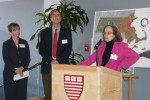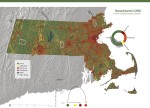Almost five years ago, 29 scientists came together for a workshop at the Harvard Forest (HFR) Long Term Ecological Research (LTER) site to discuss network possibilities for new and ongoing studies of landscape change scenarios.
Last month, the results of several of these landscape change scenario studies were featured in LTER’s 2014 mini-symposium at NSF.
Kathy Fallon Lambert, Science & Policy Integration Director at HFR, presented findings from a joint Harvard Forest-Smithsonian scenarios study and 2014 policy report, Changes to the Land: Four Scenarios for the Future of the Massachusetts Landscape (watch her presentation).
The Changes to the Land study—a first-of-its-kind, acre-by-acre analysis of the state’s forested landscape— took two years, a research team of six, and an Amazon.com supercomputer to complete. Jonathan Thompson, previously of the Smithsonian Institution and now a Harvard Forest senior ecologist, developed the study to quantify threats and opportunities for ecosystem services in Massachusetts across a range of plausible land-use scenarios.
While Thompson’s team worked on the model, Lambert and HFR director David Foster convened a group of eight stakeholders—agency and NGO experts in land-use planning, water policy, forestry, and conservation —to develop four scenarios that would reflect contrasting patterns and intensities of land development, wood harvesting, conservation, and agriculture in Massachusetts over the next 50 years.
Stakeholder engagement and outreach activities for the project were undertaken as part of the Science Policy Exchange, a new consortium of research institutions co-led by Lambert from HFR and David Sleeper from Hubbard Brook (HBR) LTER, aimed at increasing the influence of science on conservation and policy.
Report Findings
The Changes to the Land study found that although Massachusetts has made impressive conservation gains over the past eight years, recent development trends, if left unchecked, will jeopardize water quality and limit the natural landscape's resilience to climate change. But one scenario, Forests as Infrastructure, scored well on six out of the nine ecosystem benefits measured.
Forests as Infrastructure clusters more of the state’s development, implements “improvement forestry” on much of the harvested land, and increases the rate of forest conservation with a focus on priority habitat. Compared to another scenario, Recent Trends, by 2060, this scenario limits flooding risks in virtually all of the state’s major watersheds, doubles the amount of local wood harvested, maintains a 35 percent increase in carbon stored in standing trees, and protects a quarter-million more acres of high-priority wildlife habitat
Report Rollout and Next Steps
In December 2013, the study authors, together with leaders from the Massachusetts Executive Office for Energy and Environmental Affairs, presented the new report in news conferences at the Harvard Kennedy School of Government and the Springfield Science Museum. Broad uptake by 60 media outlets included a Boston Globe editorial, national coverage by the Associated Press and ClimateWire, and many TV and public radio segments.
News clips and a link to download the full report and policy addendum can be found on the Changes to the Land website. You can also watch a video preview of the report on YouTube at http://www.youtube.com/watch?v=dFf8H3e-X0E or images from the news conferences at http://on.fb.me/1pxwCek.
Over the next few years, with a National Science Foundation Research Coordination Network grant, the Changes to the Land team will expand the project to encompass the full New England region. First steps include creating a map of initial forest conditions and planning a series of regional scenario workshops.

 Enlarge this image
Enlarge this image

